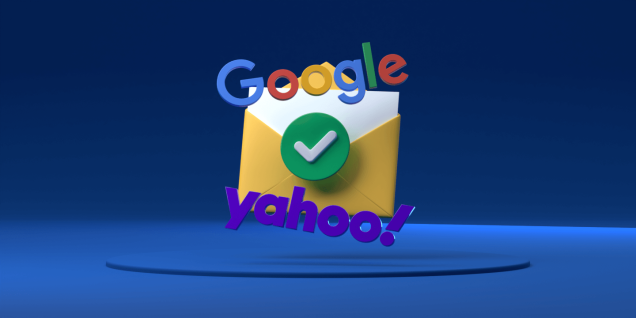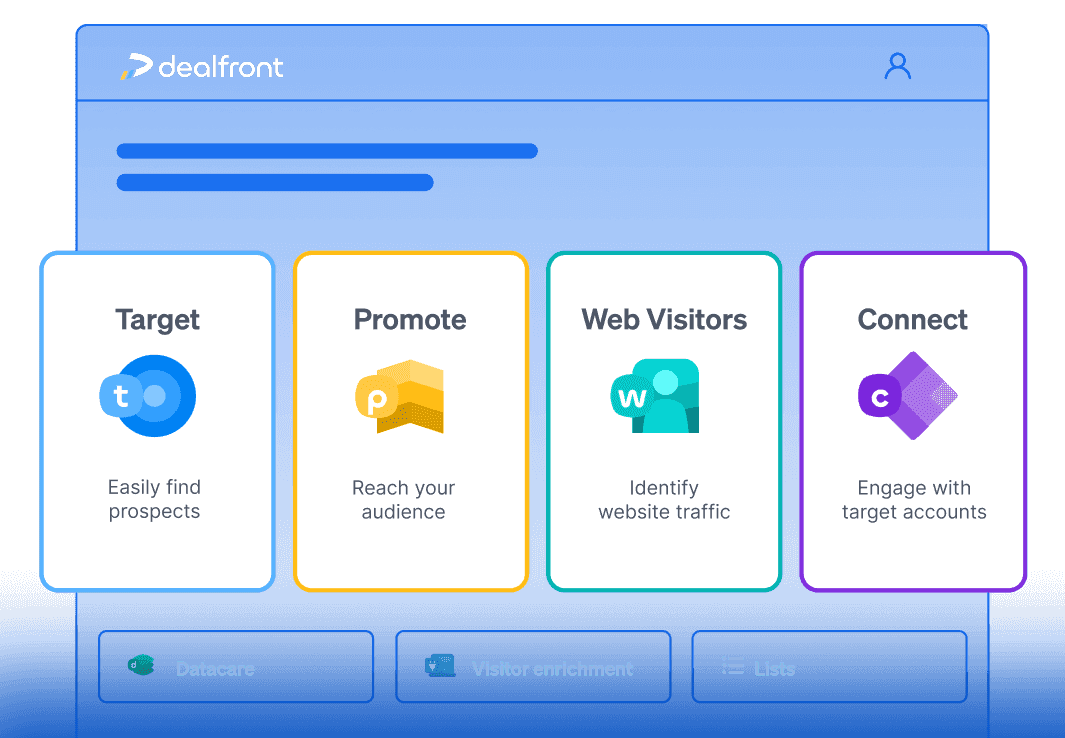It can be tempting for sales representatives to send 100 emails at the click of a mouse. Spray and pray tactics are widespread, and unfortunately, we’ve all been recipients of those terrible emails made for no one and everyone.
This outdated approach not only annoys your potential customers but actively signals that you're not interested in understanding their needs and offering value.
Email has been and will remain one of the most vital tools for sales and marketing outreach, but in order to be truly effective, it has to be done right.
To counteract the bulk email craze, Google and Yahoo rolled out their new email security policies, and the internet was abuzz. With these policy changes, we're entering an era where customers demand personalized, relevant communication. Companies that embrace this shift have a major opportunity to stand out.
Overview of Google and Yahoo’s policies
In Q4 of 2023, Google and Yahoo announced new protections to prevent inbox spam. These policy changes weren't a subtle tweak; they represent a decisive crackdown on bulk emails that lack proper authorization or ignore recipient preferences.
Google and Yahoo’s policies focus on the following areas:
Email validation/authentication
Easy unsubscription
Ensure recipients are getting only the emails they want
In theory, this means we should expect cleaner inboxes and spam folders that are easier to maintain. But what does that mean for those of us who rely on email outreach in B2B? The era of 'quantity over quality' is definitively over. Companies clinging to generic mass email practices face serious risks.
For companies clinging to generic mass email practices, these changes signal potential trouble. Spam reports don't just send an individual email into oblivion – they damage your domain's overall reputation. This could even impact your ability to deliver time-sensitive communication to legitimate customers.
Upcoming challenges for sales teams
The sales teams who only rely on ‘spray and pray’ tactics for their outreach are going to fall by the wayside very quickly. This is a great opportunity for your organization to stand out and win against your competitors.
Here’s where it could go wrong for your teams if you’re unprepared:
Decreased Deliverability: Even a small fraction of your mass emails marked as spam can damage your email deliverability. That doesn't just mean ending up in junk folders. It means even your well-crafted outreach could get blocked altogether. And it's not just marketing at risk. These changes could inadvertently delay vital transactional emails like invoices, purchase orders, and updates to legitimate customers, adding friction to those relationships. Think of your domain reputation like a credit score – sending irrelevant, untargeted emails is like missing loan payments. Soon, no one trusts you.
Potential Damage to Reputation: A ripple effect happens if enough recipients complain, causing Internet Service Providers (ISPs) to blacklist your domain. Suddenly, even the personalized and valuable emails you send to legitimate prospects aren't getting through. It takes significant time and effort to clean a tarnished reputation – way more effort than maintaining good practices from the start.
Less Personalization: Everyone’s time gets wasted with generic ‘spray and pray.’ These kinds of emails demonstrate a lack of understanding about your lead and their company. That immediately erodes trust in your organization. Prospects get flooded with emails daily – 85% of all business emails are considered spam! Your recipients quickly learn to sniff out inauthentic, low-effort messages designed to benefit you, not them. This results in deleted emails and lost opportunities.
It’s not the end of outreach, it’s the upgrade
These bulk email policy changes might feel restrictive at first. But honestly, they're a positive push in the right direction for B2B sales and marketing. Think of it this way: instead of blindly casting a huge net hoping to catch anything, you're refining your approach.
You switch to a meticulously crafted fishing lure designed to attract exactly the kind of fish you want. Sure, you might get fewer bites overall, but the ones you land will be far more valuable.
This shift gives you the chance to connect with highly qualified leads who genuinely align with what you offer. When you take the time to understand a prospect's pain points and challenges, you can craft emails that resonate powerfully.
Those emails aren't just noise in an overloaded inbox – they offer real solutions. Guess what? That leads to increased engagement and better conversations.
Besides protecting prospects from irrelevant offers, these shifts benefit them tremendously. Imagine an inbox where every message deserves at least a quick scan instead of endless sifting through generic pitches. That saves time, increases focus, and fosters better choices for their business.
Plus, nobody enjoys a bombarded inbox filled with irrelevant junk! These changes help protect your prospects' space while ensuring your brand is associated with helpful, informative outreach instead of spammy tactics. And building trust is the real currency of any business relationship.
Stop wandering in the dark. Having the right tools to upgrade your outreach will give you an advantage over your competitors.
Tools for targeted, GDPR-compliant, and effective outreach
You obviously don’t have to ditch outreach altogether. You just need to be smarter and more targeted. There are many tools out there that specialize in sales intelligence to help you understand and hone in on your ideal customers.
A go-to-market platform like Dealfront offers solutions to give you precise and current details about your target companies. The benefit here is that you avoid wasting time on the leads that aren’t within your ICP.
Dealfront Target helps you identify your ideal customers and companies as well as the key decision-makers. That way, you aren’t randomly reaching out but effectively and efficiently getting in touch with the company that needs your offering.
Dealfront proactively carries out a mail server check to validate the contact email address. When you send bulk emails, you also don’t have a guarantee that those addresses can be reached. So it’s not just a waste of time for the recipient, but for you too.
Once you’ve identified the companies that fit your target market, you can dig much deeper to gain insights to give you the edge when you reach out.
Target can give you information (Trigger Events) about whether a company has had a change in management, expanded its headquarters, or will attend a trade fair. Armed with this information, you can completely tailor your outreach to create a personalized experience for your contact.

Dealfront Target Trigger Events
You can also sync Dealfront’s data with a CRM like Salesforce or Outreach to streamline your existing workflows. That way, you’re continuously enriching your CRM with the most up-to-date company and contact data.
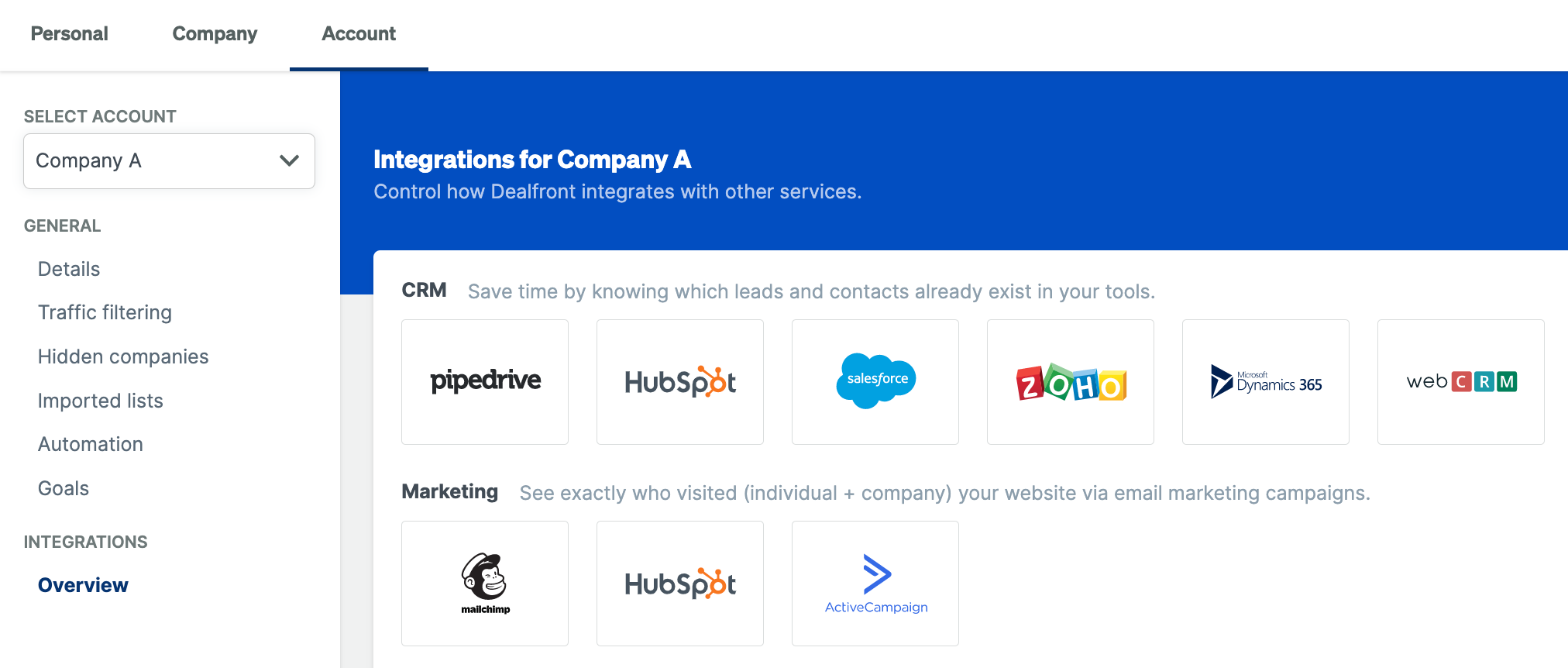
Available CRM integrations
Here’s an example scenario:
Using Dealfront + your CRM
1. List building with Dealfront: Using Dealfront Target, the sales team refines their search using the following criteria:
Industry: "Software Development" & "Information Technology"
Company Size: 50 to 500 Employees (filtering for growing businesses)
Trigger Event: "New Head of Operations"
2. Enrichment and Segmentation: Dealfront's data populates detailed company profiles. The team further segments their contact list within your CRM into two micro-segments:
"New Ops Execs": Companies who've recently hired a new Head of Operations, etc.
"Mid-Size Tech": General audience in their sector who may be seeking efficiency solutions.
3. Personalized outreach campaigns: The team designs email sequences within their CRM. Instead of generic pitches, these leverage insights from Dealfront:
For "New Ops Execs," Emails reference the challenges of taking on a fresh operations role, with the software positioned as a tool to streamline workflows and track project success for an impactful start.
For "Mid-Size Tech," The focus is on pain points around scaling projects effectively, offering case studies demonstrating efficiency gains for similar companies.
4. Data sync: Throughout your CRM campaigns, email engagement data flows back to Dealfront. This continuous loop ensures that future targeting becomes even more refined based on behavioral insights.
Outcomes
Within the first month, the tech company sees a significant improvement with these campaigns compared to their prior "spray and pray" approach:
Increased open rates Personalized subject lines grab attention, especially for executives facing the exact challenges mentioned.
Greater Engagement Tailored content addresses the specific needs of each segment, boosting reply rates and requests for more information.
Cleaner Data Dealfront's email validation, coupled with direct feedback from your CRM’s activity tracking, allows the team to quickly remove invalid addresses, maintaining excellent deliverability.
These three things aren’t just about individual tool capabilities. Integration between Dealfront's insights and your CRM’s streamlined workflows helps the sales team spend less effort on mundane tasks and more time on strategic, high-quality conversations with the right leads.
Data privacy and deliverability: The importance of GDPR compliance
Another important aspect of the platform is that the Dealfront data meets the highest industry standards. GDPR compliance is vital if you want to reach out to companies in the EU. So, if your chosen tool doesn’t meet those standards, you’ll be setting yourself up for even more challenges when you reach out.
Dealfront is built on public and trade register data, and you will always be able to trace the data to its source. Also,100% of the data we have is processed within the EU, ensuring that your contract with us is subject to the strong EU legal framework. So be sure to do your homework when evaluating a data provider for your business.
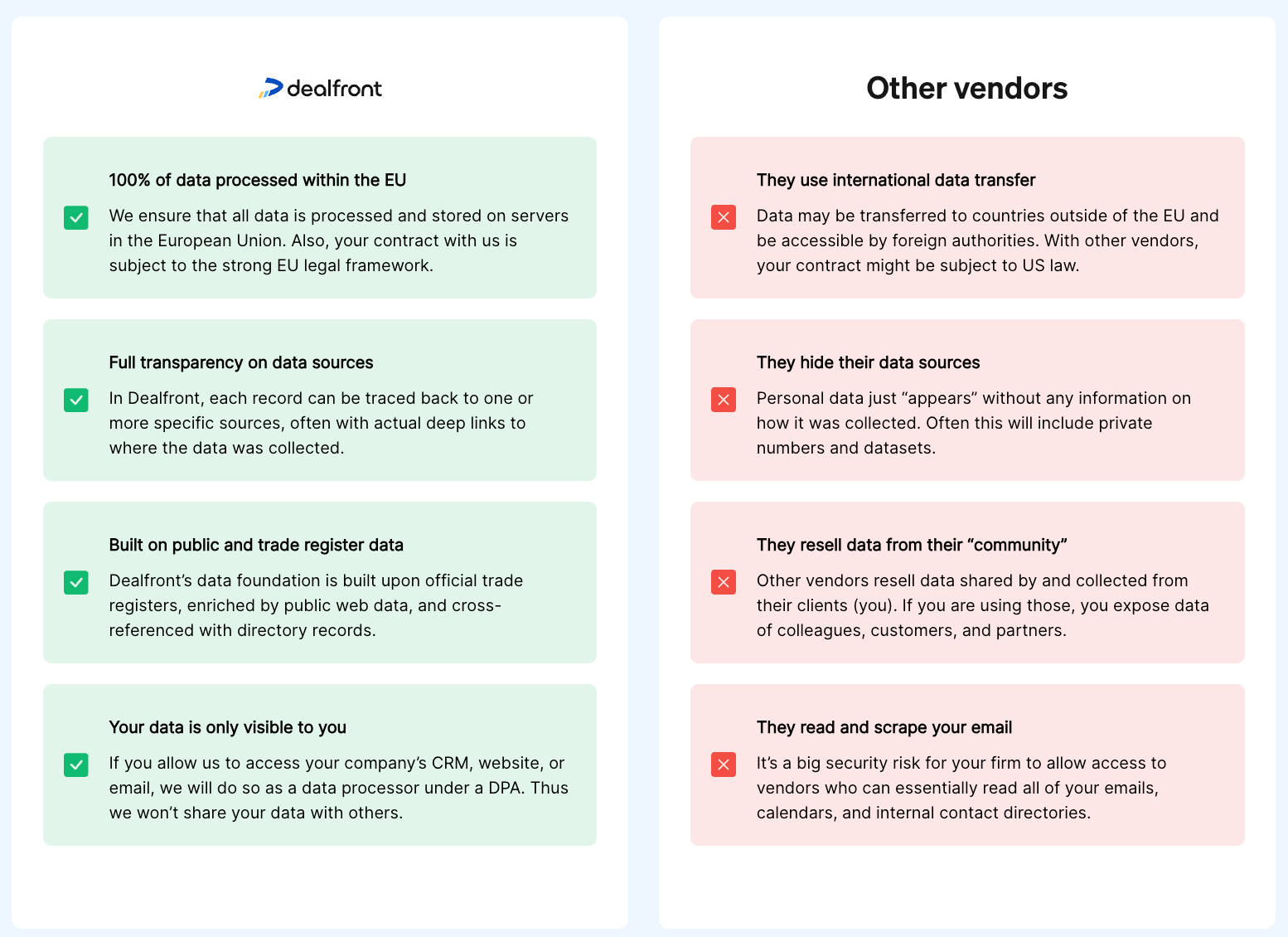
Now you understand the challenges, why these changes are good for you, and examples of how you can overcome them. How can you stay ahead of the game?
Mastering email essentials: Strategies for deliverability and engagement
Technology is essential, but to truly excel with these bulk email policies, strong email fundamentals are critical. These foundational practices help ensure your messages are not only delivered but are eagerly anticipated by your recipients.
Let's break them down:
1. Healthy lists lead to healthy results
Don't be fooled by the lure of massive email lists. Outdated or incorrect contact info leads to high bounce rates and spam reports. Dedicate time to list hygiene – validating email addresses, verifying information, and removing inactive contacts. A pristine contact list of your ideal customer profile guarantees a greater return on your efforts.
Think of list maintenance as preventative medicine for your email reputation. Waiting until deliverability problems appear means you're already facing an uphill battle.
Regularly pruning outdated contacts, proactively weeding out bad email addresses, and ensuring data accuracy protects your sender reputation before complaints hit your inbox. This investment in a healthy list isn't just about the immediate open rate - it safeguards your ability to effectively reach your target audience long-term.
Now that your list is healthy, let's make the most of it with strategic segmentation…
2. Segmentation is your secret weapon
Blanket email blasts simply don't, and have never been effective. Instead, segment your lists based on criteria like industry, job function, or demonstrated pain points. This strategic division enables you to craft truly targeted campaigns. Your prospects won't feel like a number on a list – they'll feel like you are offering content specifically designed for them.
Here are various effective segmentation methods, with examples, to supercharge your email outreach campaigns:
Demographic Segmentation
Job Title: Target decision-makers at the appropriate level (VPs, Directors, individual specialists, etc.). Example: A tailored campaign based on the unique problems faced by Marketing Managers can provide them with highly relevant solutions.
Industry: Reach companies facing industry-specific challenges. Example: A software provider could segment potential clients based on verticals like finance, healthcare, or logistics, allowing them to address pain points unique to each.
Company Size: Customize pitches based on the needs of businesses of different sizes (enterprise, mid-market, startups). Example: An automation tool targeting SMBs (small to medium businesses) with limited staff would benefit from highlighting that their solution requires minimal resources to run.
Behavioral Segmentation
Website Interactions: Identify leads who browsed specific product pages or downloaded resources. Example: An individual exploring your pricing section suggests a higher level of purchase intent, warranting an email that addresses pricing tiers and comparisons. Leadfeeder by Dealfront is a great tool for web visitor intelligence. You’ll be able to see the companies visiting your website, and you’ll get insights into which pages they’ve been visiting.
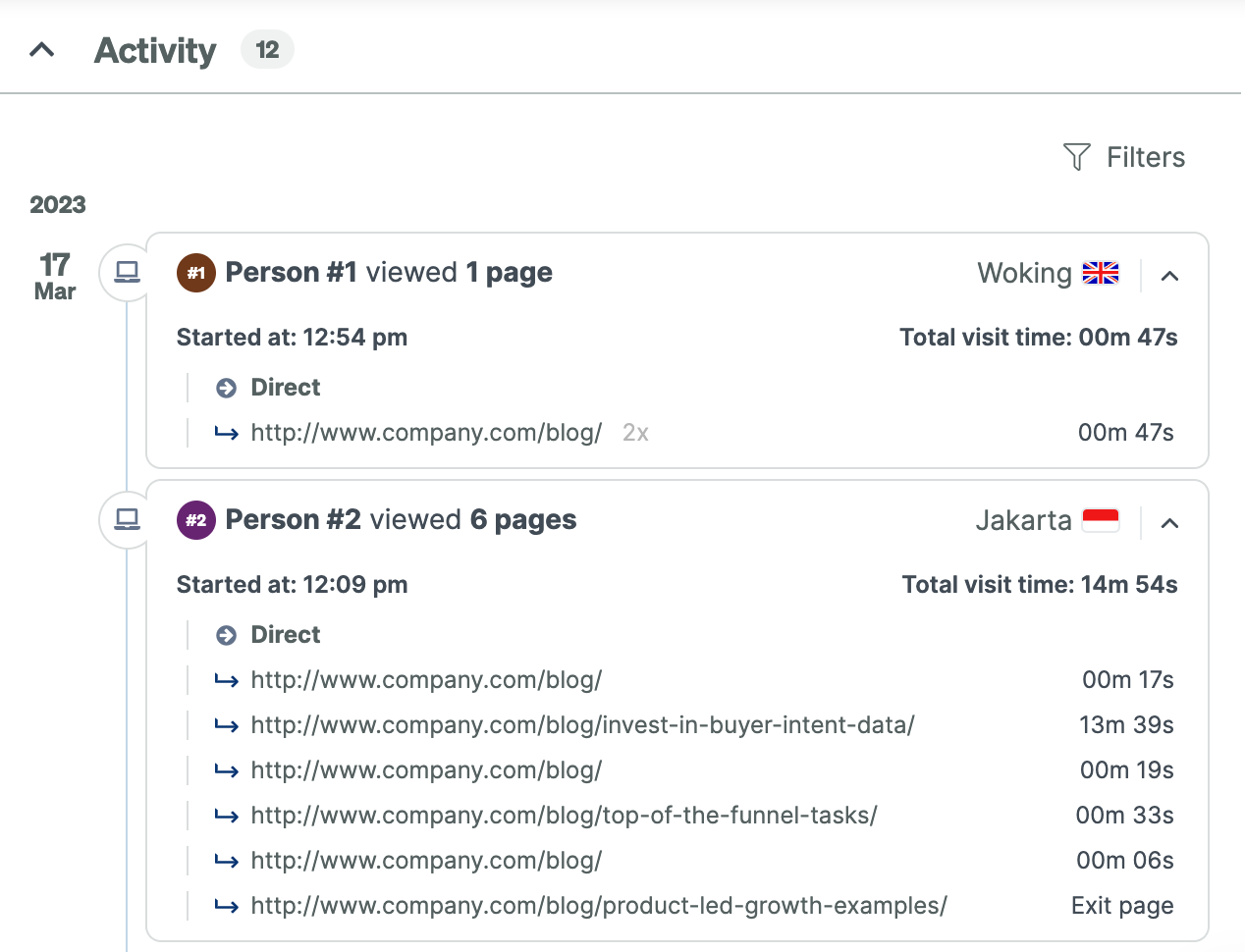
Past Purchases: Use purchase history to offer complementary products/services or targeted upgrades. Example: Someone who bought an entry-level subscription could receive an offer to unlock advanced features through a premium plan.
Email Engagement: Group recipients based on open and click-through rates. Example: A disengaged list can be sent 're-engagement' emails offering unique high-value content.
Psychographic Segmentation
Interests: Reach audiences based on specific product interests or industry trends they follow. Example: If your prospect actively consumes content on machine learning, tailor your outreach around applications within their sector.
Pain Points: Address challenges prospects frequently face and demonstrate how your solutions help overcome them. Example: Focus on a client pain point like cost reduction when selling productivity software.
Values: Highlight how your offering aligns with what companies prioritize (e.g., sustainability or innovation). Example: For a client valuing diversity, emphasize how your service supports their inclusivity initiatives.
Additional Tips
Mix and Match: Don't limit yourself to just one segmentation method. The sweet spot often lies in combining several criteria (e.g., targeting marketing managers in startups, specifically those who've viewed specific product pages).
Start Simple, Iterate: Don't be overwhelmed initially. Choose a few key segments and expand as you gather data and insights.
Tools Help: Many sales engagement platforms (Salesloft, Outreach) and marketing automation tools have built-in segmentation features to refine your lists.
Value is the Ultimate Currency
Gone are the days when you could win with a pushy sales pitch in the first sentence. Think carefully about the potential problems your prospect faces.
Is there valuable industry data you can share? Could you address a common pain point in a brief tip? Focusing on delivering tangible value first builds trust and positions you as an expert, fostering longer-term customer relationships.
Don’t forget to include clear and easy-to-find unsubscribe links in your emails. These changes by Google and Yahoo focus on giving recipients control, and respecting their choices is vital for both compliance and reputation.
The key takeaway here is that while technology enhances your outreach, mastering these fundamentals guarantees both email deliverability and a significantly warmer reception in inboxes.
Winning in the new era of email outreach
The bulk email policy shakeup isn't a roadblock; it's an upgrade. Now's your chance to ditch generic outreach and forge genuine connections with the right prospects. Target with precision, and every email becomes a powerful conversation starter. This focus on quality builds trust and separates you from the competition.
Maneuvering this shift may seem daunting, but you don't have to go it alone when you have the right knowledge and tools. So, why not jump right in and start standing out as a company that truly understands how to make email impact today?
